|
|
Post by Administrator on Sept 25, 2016 0:46:20 GMT
My exampler of a virtual legal representative. I will post this in the legal section as well. I have used the example with a Mr. U. R. Wrong, instad of my own details in this example. I have used my version, to make representation to the court, police and CPS.
Note, that when it states that the driver statement "May" be accepted by the Court. What It means is that it is "permissible in LAW" for the statement to be accepted "when produced/filed for that hearing". It does not mean that the court "May or May not" choose to accept it at their discretion, if it is produced. And the Prosecution can not object to it being read out, in the absence of the driver. As it is crtitically required. The prosecution are likely to have a trend and co-culture with the court of attemptinge to coast through cases with wins banked on their objecting habbits. Whwn in truth those objections are limited. in this situation facing an MS90 offence the statement itself is on Par with the guilty or not guilty plea of a charge. because production of the driver statement, would have the ability to render a guilty plea as "not guilty" by the court. via virtue of truth, if the statement were signed and contained a statement of truth within it. It would contradict a guilty plea. Unless the court was rigged to find them guilty regardless of evidence.
|
|
|
|
Post by Administrator on Sept 25, 2016 13:00:53 GMT
my virtual legal representative:
Regarding Production of the driver statement, filed with the court, produced by the clerk. In a hearing that concerns an MS90 Charge in a defendents absence. Over previously being alledged to have provided details of the driver or driver statement to the police or prosecution.
|
|
|
|
Post by Administrator on Sept 26, 2016 21:45:34 GMT
So....... Because the " Truvelo " speed cameras, supposedly (or do) run on those Peizo strips under the road... They must be more accurate than "Inductive loops" magnetic field. On Traffipax traffiphot III cameras. But with the Truvelo, the 3 stripes are supposed to ADD + and MINUS -, 10% of the speed limit, depending on what car it is. So, if there is only ONE stop line on a traffipax, traffiphot III camera.. and is not Peizo strips.. but a much less accurate magnetic field, that interaxts differently with various vehicle sizes, riding heights and metal mass strengths... How are you supposed to worl out the +10 and -10% to be able to calculate the exact distance from the lights that vehicle was at when the amber light came on. To genuinely establish if it had time to stop or not?  I dont think the Police Court presentation officer would care to do a live Q&A set to an audience about it. He is happy with his little dummy model, mock court presentation and accident calculation trigoknowmetry devizes.  (not to forget on-site sign evaluation for insurance purposes) 1.21 seconds into RED! thats half a second later than my 0.7 second time! but it does not tell you what speed he is going at!!  How are you supposed to work out the distance at amber for legislative purposes of defence?! you could be going 5mph or 25mph!   This system looks interesting. Lets just stick with evaluating the traffipax for now?   |
|
|
|
Post by Administrator on Sept 27, 2016 18:37:46 GMT
Court forms... www.justice.gov.uk/courts/procedure-rules/criminal/forms#Anchor9The Magistrates re-hearing form is not there. And I believe left out on purpose. Magistrates court criminal procedure rules? Section 142 Magistrates Court act 1980 You can get the Australian one and the UK crown court re-hearing form and the legislation and kind of put together an accurate appeal form. www.magistratescourt.vic.gov.au/forms/application-re-hearing-form-46bForm 46b As for the UK, I don't think there is a form. Actually it is simply the power to rectify mistakes. It need not be a re-hearing as per se. If it involves multiple drivers... Why would you have independent re-hearings? (Criminal procedure rules part 38?) Magistrates’ Courts Act 1980 1980 c. 43 Part VII Power to rectify mistakes etc. Section 142 Which is ridiculous if you consider they are constantly re-hearing cases from the traffic light camera over and over. New cases.. all with the unlawful stop line! |
|
|
|
Post by Administrator on Sept 27, 2016 22:36:00 GMT
I wonder if Cheshire police and court convicted me to see if I had the balls to carry on driving for the petition work... Even though I had been disqualified...
But that doesnt help out other drivers who have been caught by the camera.. (if they have even been using it still)
I am interested in this traffic light camera that has no vehicle speed on it.. and how the evidence informs the court at what speed the vehicle was moving.. to establish how far away from the traffic lights it was when the light went to amber.. and if it was one or 2 meters away.. would that still constitute an offence?
Or if the distance was 2 meters.. are we to guess the speed was very low? And that the vehicle would have had time to stop? But would it have been too close to actually see the traffic light signal from beyond the restrictions of the windscreen perimeter?
One thing is for certain. The police like devices that leave a lot to the imagination. And not over informative on details....
I wonder how their James Boothby forensic buisness partners fair on machine accuracy in forensic machines Vs vehicle enforcement?
|
|
|
|
Post by Administrator on Sept 28, 2016 0:25:34 GMT
|
|
|
|
Post by Administrator on Sept 28, 2016 14:15:44 GMT
The Police REALLY DO NOT WANT TO DO OFFICIAL Q&A REGARDING THE SPEED CAMERA MARKINGS, Road signs, REGULATIONS, ENFORCEABILITY OR RESPONSIBILITY! (even though all information is mostly available online and there should be no reason not to confirm what it says, by official statement) by truth & honesy police employment policy.[/b
West Yorkshire police Casualty Reduction Partnership
YJ14 CWL with officer. 28 September 2016 at 11.49
Safety camera technician is not fit to give evidence in court, or present a demonstration of the cameras.
OR refuses to discuss or comment about the required sign checks or the road marking information concerning operation of the camera & its legal enforcement & correct use.
I just left the House to post letters for an appeal as the Police Road safety camera partnership vandrove past & stopped at the fixed truvelo camera newar our house. the only one in several on the road, with incorrect markings, not uniform with the other cameras of the same type & model.
I thought this seemed more than co-incidence.
West Yorkshire police Casualty Reduction Partnership
YJ14 CWL with officer. 28 September 2016 at 11.49
Truvelo speed camera with suspected incorrect road markings, not uniform with the other identical cameras on the same road.
Truvelo cameras use Peizo strips and a +/- 10% triple strip configuration road marking.
Not the gatsometer long distances stripe layout.
I question the officer over these markings. he either does wan to comment, or does not know.
He suggests asking the council. as they are in charge of the road markings.
I disagree. that Kirklees council traffic light management have confirmed that the council does not install the cameras, or the road markings. nor do they enforce the speed limit.
The police officer of YJ14 CWL claims it is the council not the police who are in charge of the road markings & stop lines.
When i question the officer regarding TSRGD sign checks by the police, that are required periodically, he, smiles friendly, and gets in his van, keeping silent, refusing to comment.
and locks his vehicle. It was a friendly exchange of comments.
I walk away to post letters and get fish & chips. he is not there when i pas on the way back home & he did not service any of the other cameras on the road, as far as i am aware.
I wanted to add the questions to him, if he gies evidence in court about the camera prosecutions? and if so he must be fully trained & knowledgeable about the camera, operation, functions, all details about the road measurement markings and also the traffic light stop line calculations (forgot to ask him about how you work out the amber light position if the speed cannot be verified)
Also when I got home, the Parcel force/postman had been & left a package. It was a poster that i had ordered. of a steve jackson book. The poster features a character with content comparable to the LTI ultralyte devices. I thought it was significant that the poster was delivered just after the encounter with the vehicle YJ14 CWL, where I got to ask questions to the officer. He was friendly, but did not wish to give full answers or comment to my questions. and directed me to ask the council. where when asked, the council direct questions at the police.
The complaint is not against the officer, in this instance it is regarding the road markings being incorrect for correct operation of the camera.
Also that these officers should not be giving evidence in court regarding speeding convictions, if they cannot openly discuss or are not knowledgeable in the technical operation, markings and use of the camera and the legislation around its authorization for lawful use. because I have been in a court in bolton & the Officer there giving evidence, was the camera technician, same job position as YJ14 CWL. and he must know about the road markings for both red light & fixed speed cameras, to be able to give the court demonstration and presentation before the magistrates. so i believe that he should not be giving evidence or is refusing to answer questins because he does not want to admit that road signage is not lawfull at the sites.
I should have asked him how they work out the distance from amber on some cameras that display no vehicle speed.
|
|
|
|
Post by Administrator on Sept 29, 2016 11:33:01 GMT
|
|
|
|
Post by Administrator on Sept 29, 2016 16:49:49 GMT
Ive just made a new compilation video from a few videos added at different dates to the website.. where it will be better to watch them together to make better sense of how the concerns are connected.
Ive also done some more writing on the Maclesfield Silk road camera, with the prescriptive manual references added in.
Also note that, if a traffic Warden can give a driver a ticket for a RED light offence... and they work for the council.. does the council process the RED light offence? or pass it to the police? and if a council Traffic warden is enforcing a set of traffic lights... then they and the council must be able to withdraw a RED light TS10 offence prosecution/ticket, thus i do believe that if the traffic light stop line & signs are unlawfull & an obstruction.. the Council can have ALL the offences at the traffic light dealt with & have no right to attempt to point the finger at the police. And claim they the council cannot act to resolve the problem of the incorrect convictions.
Evidence presentation to go with the video evidence labelled "Trying to get the truth out of the Authorities. Police VS Council. both blaming each other"
the Road traffic regulation act 1967. chapter. 76.
75. -1. it shall be the duty of the competent authority -
(a) to erect and maintain the prescribed trafic signs and markings, in such positions as may be requisite in order to give effect
to general or other directions given by the appropriate minister for purpose of securing that adequate guidance is given to drivers of motor vehicles.
as to whether any, and if so what, limit of speed or other signal is to be observed on any road.
The Traffic signs manual, chapter one. legal aspects and responsibilities for signs.
1.18. the use on public roads of non-prescribed signs which have not been authorized by the secretary of state, is illegal.
And authorities, including the police as a road traffic authority, who so use unauthorised signs, in connection with enforcement, act beyond their powers.
additionally, an unauthorized sign in the highway is an obstruction. the possible consequences of erecting or permitting the erection or placement of obstructions may be severe.
and those responsible could lay themselves open to a claim for damages. for example, if the obstruction is the cause of an accident or injury. or renders and insurance policy void.
Or if a collision, accident or injury occurs, where a sign is missing, or its view is obstructed or otherwise fails to remind or notify a driver to check their speed.
or be given any other direction at the prescribed distance, time or moment.
in the legislation governing the traffic light and stop line, page 428.
1. this paragraphapplies to traffic light signals.
2. the significance of the light signals to which paragraph 4(2) applies, when illuminated, is that specified in sub-section 3 to 9.
3. subject to paragraphs (4). to (6). the RED signal. conveys the prohibition that vehicular traffic must not proceed beyond the stop line.
Thus this gives legislative requirement for a stop line. and one that must be the prescribed size. or it is an unlawful sign and an obstruction to vehicular traffic.
If a stop line is not provided. the vehicular traffic is required to stop adjacent to the first RED traffic light signal.
But there would be no unlawful, un prescribed stop line in that instance to cause an obstruction. or be an unlawful sign.
Although, without a stop line in place there to give lawful effect to the RED signal stop position. the position to stop at adjecent to the traffic light post, would be for safety guidance only, as temporary.
and the red light signal would not be lawfully enforceable. especially if it were a site with care taken to place and maintain a permanent enforcement camera. the entire road signage would be required to comply with the TSRGD for lawful enforcement.
Not with the legislative guidance for what to do when there is no stop line present. Because the section 85. of the road traffic regulation act chapter 27, states that no speed or signal is required to be observed and no conviction possible if the prescribed signs and markings are not in place.
(4) and (5) give general (but not all possible) instances of where a vehicle being used for a special purpose, and the observation of the prohibition (in this case a red light) would be
likely to hinder the use of the vehicle for that purpose.. then the prohibition does not have to be observed for those purposes.
Exemption from the jurisdiction, of a police camera, on a road by legal authority of exemption from prosecution, would be and is a valid addition to the listed vehicular uses in this legislation.
Purposes of: fire and rescue authority. scottish fire. ambulance. blood service, a response from an NHS ambulance. a bomb or explosive disposal. special forces.
police. and national crime agency.
this Would include and other vehicle being used for any other purpose which had lawful exemption in law, from any or all prosecutions.
Such as a political petition purpose, delivery of petition notices, survey of the road for a petition. gathering information from the road for a petition. because that is a special force.
a political force with appropriate legislative exemption from being required to observe the prohibition.
the prohibition conveyed thus is that the vehicle must not proceed beyond the stop line in such a manner or at such a time as to be likely to endanger any person.
or cause the driver of another vehicle to change its speed or course in order to avoid an accident.
Thus, it is possible to have a different prohibition in place for a red signal. but in the case of a petitioning purpose, for the vehicles use - to gather details of the red signal and road,
under the bill of rights, right to petition, absolutely no prohibition is required to be observed at all. (although common sense would follow the alternative prohibition granted to the aforementioned listed vehicles)
. respecting obvious road safety guidance, while being exempted from complying with the red signal.
We must acknowledge that dorset police and crown prosecution service do not require a red light to be observed and complied with, unless it is over the time of 1 second on RED. and the Cheshire police and crown prosecution service state a different time. so that 0.7 seconds is prosecuted. whe as in dorset, this time is not prosecuted.
Thus we have questionable human rights concerns over fair treatment in law across the united kingdom, in these cases. that are all governed by the exact same legislation and code of decision making practice.
Back to the subject of the prescription size of the stop line...
the information on the prescribed size of the stop line is given in at least 3 books. and has not changed, by the 2016 updated TSRGD.
the books are TSRGD 2002 to TSRGD 2016 and the traffic signs manual chapter 5.
the prescribed sizes for the traffic light signal (red light) stop line are on page 157 of the 2002.
traffic signs regulations and general directions.
schedule 6. road markings. regulation 11(1) and 3.
1001. vehicular traffic must not proceed beyond the line when required to stop by light signals, by a constable in uniform or by a traffic warden.
so a local council civil enforcement authority, may have jurisdiction over the traffic light enforcement fines, penalties and complaints.
the stop line sizes given are 200 millimeters. and 300 millimeters. the larger size to be used when the road is likely to have more wear from heavy traffic. or not be illuminated, in the countryside.
in the 2016 traffic signs regulations and general directions number. 362. statutory instruments.
the prescribed stop line is on page 468. table. 46. diagram 1001. vehiculat traffic must not proceed beyond the line when required to stop by light signals, by a constable in uniform or by a traffic warden.
the sign marking sizes are 200 millimeters and 300 millimeters wide. there are the only permissible sizes. as if not correct, they could convey an altogether different prohibition to vehicular traffic.
such as on page 147 of the TSRGD 2016. part 6. regulatory road markings. sign table - schedule 9. part 6. 1. diagram 1002.1. description. vehicular traffic must not proceed beyond the line when required to stop by, the stop sign. diagram. 3. a 400 millimeter line.
that is for a stop. then give way, when clear junction.
thus, if the prescribed stop line is not correctly 200 millimeters, or 300 millimeters, but a unprescribed size, between 300 millimeters and 400 millimeters, the stop line can be mistaken for conveying an altogether different prohibition.
The added fact that, at the macclesfield silk road junction.. there is a give way slip road that fork at the junction, with vehicular traffic that drives to the left, using a give way prohibition. but with a red light signal next to it. the vehicular traffic can easily be confused.
thus it is extremely important for the correct prescribed type of stop line only, to be used on the road. at both sides of the red light signal. in this case. as there is more chance of confusion to the driver with this particular junction configuration.
in the traffic signs manual chapter 5. published in 2003. a complimentary manual to the TSRGD. we have further details about the forementioned prescriptive requirements.
page 8. 3.7. traffic light stop line.
the marking in diagram 1001 consists of a single continuous line 200 millimeters or 300 millimeters in width. and indicates the position beyond which a driver must not proceed when required to stop by light signals.
the 200 millimeter width is generally for use in urban areas. the 300 millimeter width should be used in rural areas, or where the 85th percentile speed exceeds 35mph.
not that this is not the case with the macclesfield silk road. as the speed limit is 30mph and 40mph. But it also states that
the greater width may also be used in urban areas at difficult locations, or where heavy traffic results in rapid erosion of the marking.
this statement is really a disclaimer to let authorities switch between the two sizes at will. and there is no real true correspondence between the use of either, if you survey examples around the country.
Still, no permission is given for any other size of stop line to be used at all.
on page 7 of the same book. traffic signs manual chapter 5. on page 7. we have legal information given.
2. legal.
prescribed markings and road studs.
2.1
All road markings placed on a highway or road
to which the public have access must be either
prescribed by Regulations or authorised by the
Secretary of State for Transport in england. as
appropriate
2.4
Certain road markings may be used only if
supported by a traffic regulation order or other
statutory provision (direction 7), whilst others,
e.g. Give Way markings (diagram 1003), have legal
implications in that not complying with them could
constitute a traffic offence under Section 36 of the
Road Traffic Act 1988 (regulation 10). Some road
markings may be placed only in conjunction with
certain other markings or with specified signs
(direction 18)
2.5
Care should be taken to ensure that markings
are used only in the manner prescribed in the
Regulations, and that no non-prescribed marking is
used unless it has been authorised in writing. Failure
to do so may leave an authority open to litigation, or
make a traffic regulation order unenforceable.
thus i rest my case. and have provided video evidence of measurement. that the macclesfield traffic light stop line is 330 millimeters to 350 millimeters and not an authorized, or prescribed size. it is unlawfull, it can be misread as a completely different prohibition. especially at the silk road configuration where vehicular traffic at either side of the red light signal, have different stop lines & prohibiltions. and vehicular motions. it is an obstruction in the road. and renders the traffic regulation order for the red light signal, not enforceable.
this is confirmed absolutely in all updated manuals and legislation. and the traffic light signals stop line has been incorrect for at leat three years if not longer.
Any convictions against drivers at this red light enforcement camera, must be corrected, as an error has beeen made in law. and penalty points, must be removed as well as convictions. and fines refunded to the drivers.
|
|
|
|
Post by Administrator on Sept 30, 2016 11:59:10 GMT
Ok, so.. as i suspected, as soon as you identify to the POLICE (Crown prosecution service) or Magistrates Court that you are not defending your acts or actions regarding a driving offence. But contesting the enforceability of the road/jurisdiction. The Court before the FIRST hearing, must check to find out if a decision has already been made regarding the matter, that a decision by a Higher court (crown) court has already heard/decised on that will effect all other cases in relation to that decision or order. And any NEW CASE* must be directed to that higher court. Not the magistrates Court. and if it was heard by a magistrates Court, then it will be void and null (set aside) or in fact be treated as if the case had been adourned. Because you do not need to appeal a decision to a crown court or higher court, that in the case in question, the magistrates court did not have authority to decide on. because the matter has or had previously already been raised to the Crown Court.
Which, covers both Criminal proceeding AND Civil Proceedings. And all Appeals. in fact, rule 11. to contest court jurisdiction in Civil Proceedings would actually be for a reason like this. But it Does cover criminal proceedings as well. Only that most type of case... Theft, fighting, fraud.. would usually not be significant in this circumastance. It is only when we bring Traffic regulation orders and the enforceability of a road into question, that a decision made by a higher court that would effect all the drivers by that decision, must be only able to be heard in an equal court, not a lower magistrates Court....
Here i wrote some more on it.. Its specific to "A decision" that would effect other cases, or which other cases are related by the same decision on a matter. (there are some words floating about like organ & property & nuisance if you check the source material. but i am certain that i am right on this.
|
|
|
|
Post by Administrator on Oct 1, 2016 0:26:45 GMT
So it seems like the time that the 330mm-335mm unlawful stop line has been there is about 7 years, Here we see the OLD road markings & stop line configuration. (ive posted this before) it has 2 stop lines, but not a bike lane. it looks like an early prototype bike lane effigy. (i think there were cameras in Poynton around that time that have since been removed) so i dont know how these 2 stop lines figured into the camera timing. but they were changed. thats for certain. This March 2009 google maps record has now been removed from google maps, so you would have to check their archives. i was lucky to get this image. unless they keep changing the content. 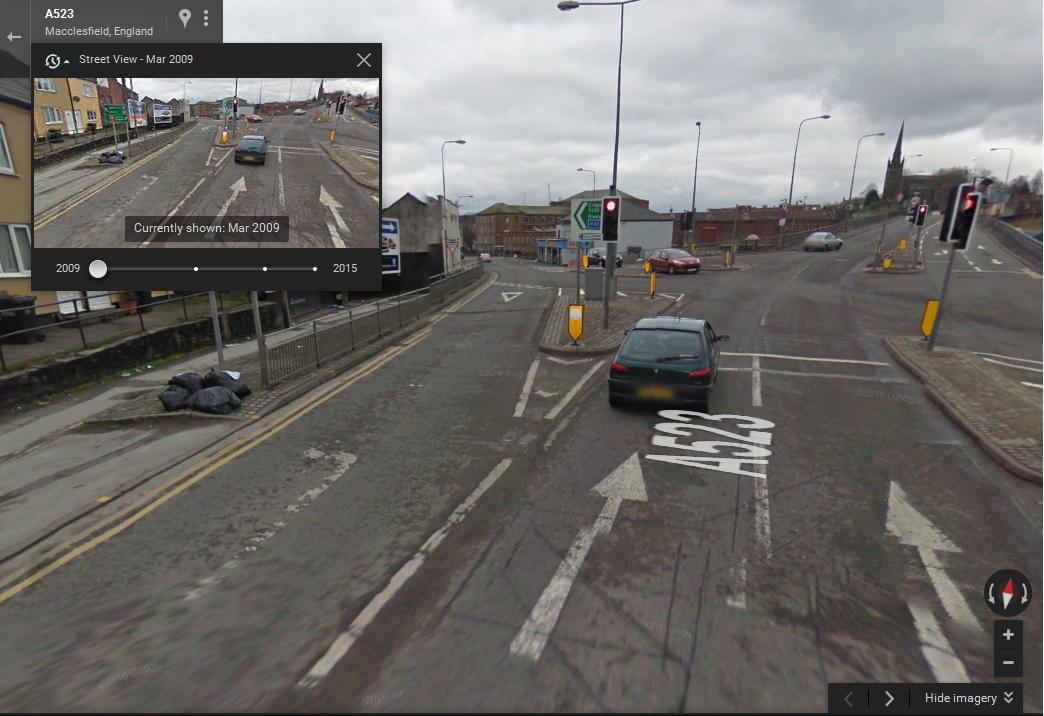 May 2011, the thick stop line is here now & looks hardly worn. thus new. 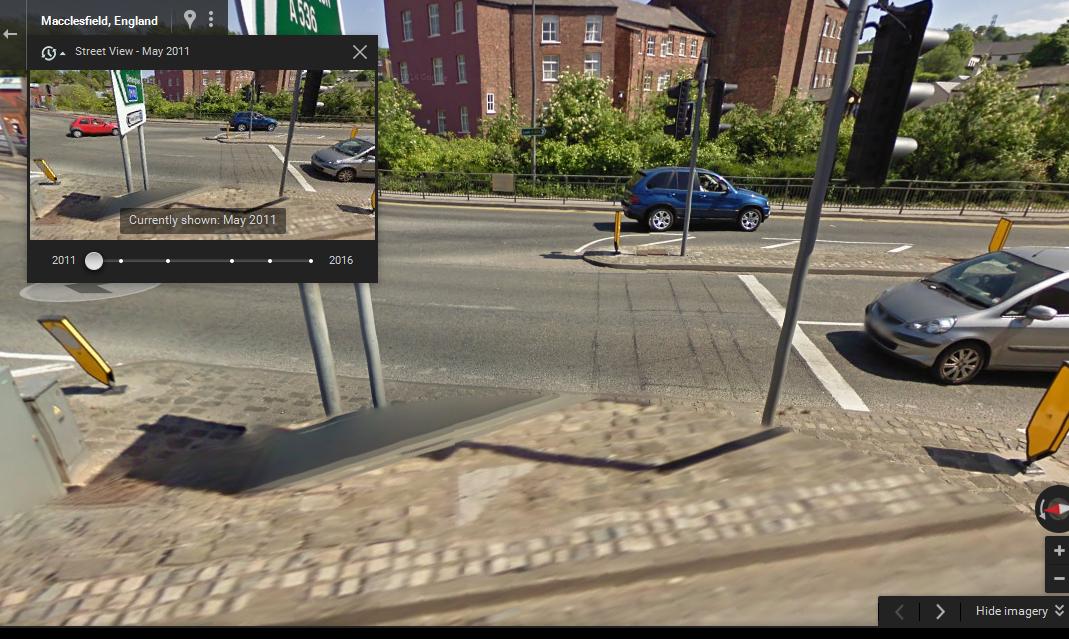 August 2011.. yes still looking quite strong paint. 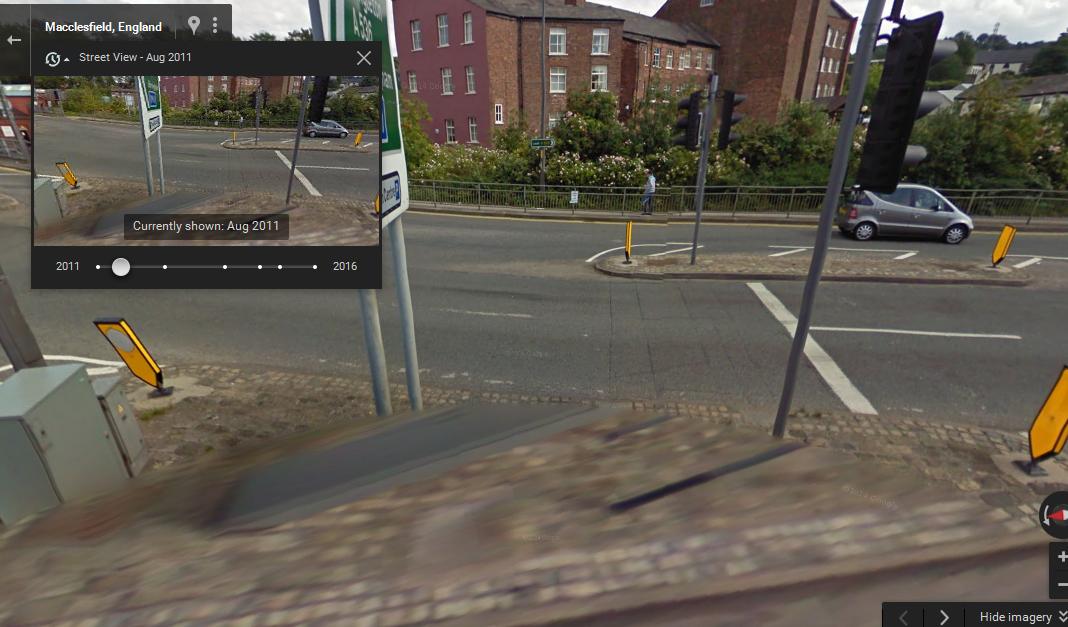 in the 2012 record we find this workman doing something inside a power box. but he mysteriously vanishes as the google car drives past & cars appear from nowhere.. so the google car driving past is not "seamless" which means it must be different google car dates, which are overlayed.. or there has been some tampering with the records... i wonder what the workman was doing? i hope not messing with the traffic light timing?  i would expect that someone knows exactly who has done what to every sign, traffic light setting and speed camera. Just like a happened upon the Rochdale camera being tampered with by a Local Council guy in a flatbed truck, not a foreign speed camera technician. - Shortly after there was a accident there, the camera has gone & the newspaper covered the story. Seems too much of a co-incidence to me. seems like the local councils DO "dick around" with these cameras after all. either in collaboration with, or seperate from the police camera technicians. 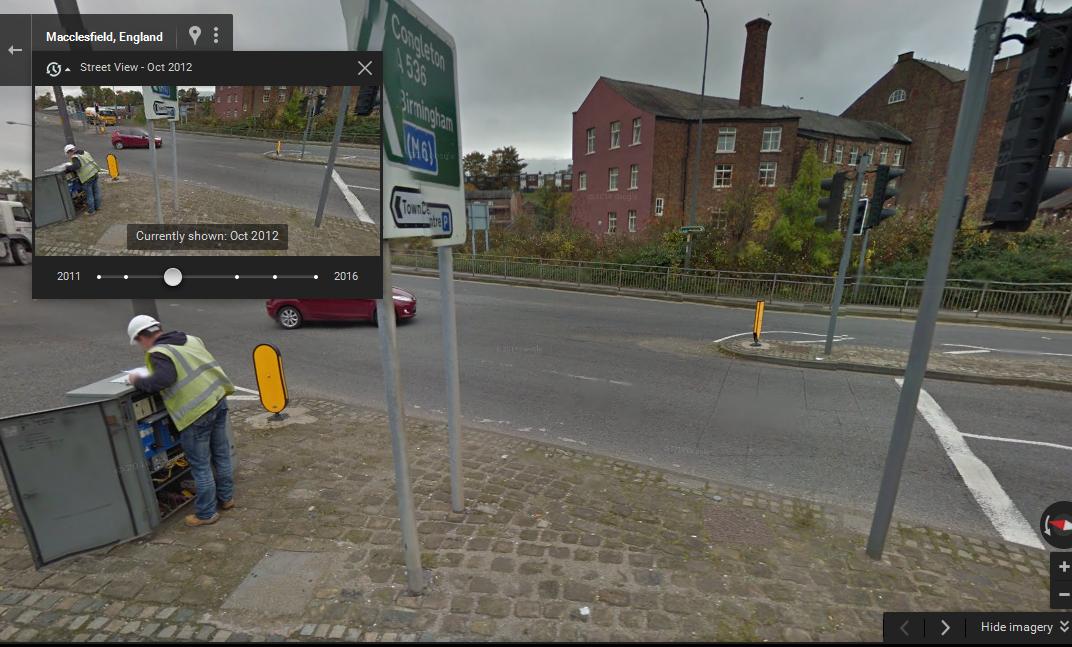 2014 the stop line is starting to wear away a bit. but it wears even across! so having a "Wider" stop line 300mm rather than 200mm seems pointless! seems to be like a department of transport con. because they give regulation for line deepness as well. and a thicker line deep will last a lot longer than one fatter. as the paint is thicker. But ive had an idea, why dont they use a coloured tarmac set into the road. And it would remain a white colour no matter how worn it got. it would save a lot of money repainting the lines! ?  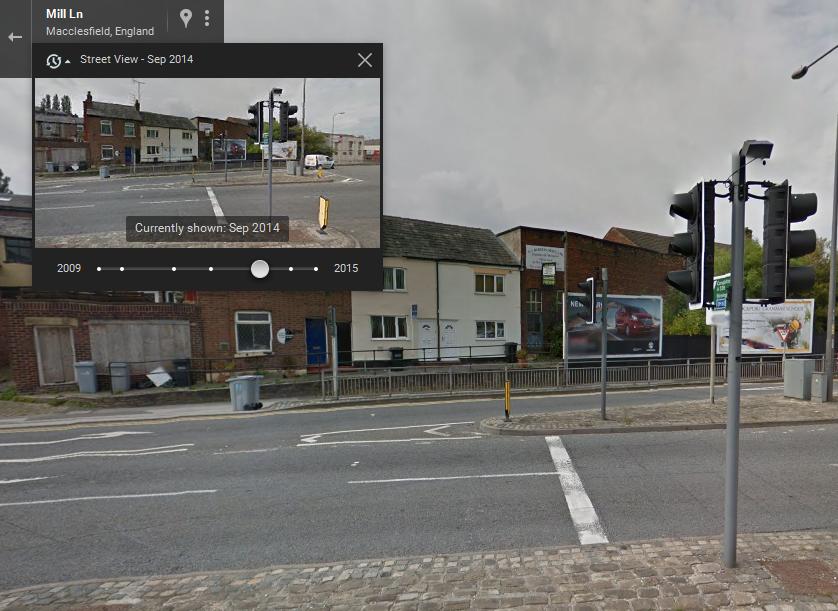 and here 2015, quite worn in places now... and that is it because the next year 2016 is now with the videos i did earlier in the thread... 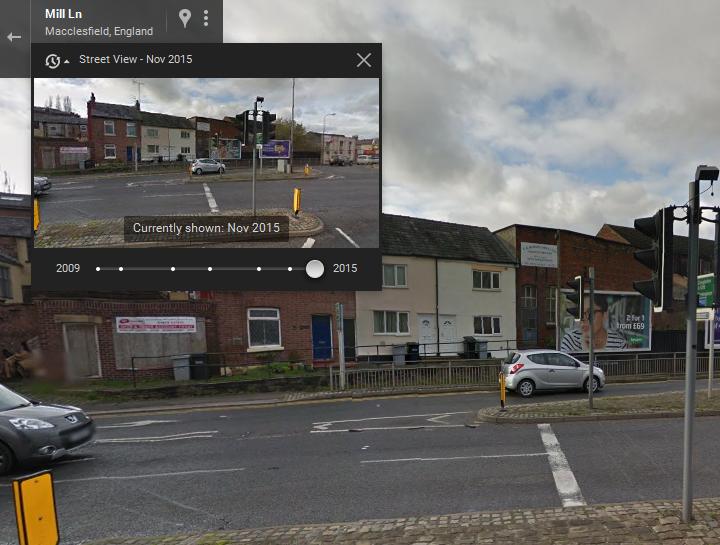 |
|
|
|
Post by Administrator on Oct 2, 2016 13:11:51 GMT
|
|
|
|
Post by Administrator on Oct 3, 2016 6:30:53 GMT
The Road Traffic Act 1991 Penalty points. www.legislation.gov.uk/ukpga/1991/40/section/27I am pretty certain that what this is saying is that a court can only apply points to a driving licence via the DVLA of the fixed number allocated to that offence unless it is giving a variable number. Like say 3-6 points. But an MS90 can be only 6. It says that a court can give a lower number or 0 points. If there are 2 or more offences. But i am quite certain that the purpose of that it for reason when a court is NOT going to disqualify a person. They can apply the conviction but give less points. Not give less points or miss an endorsement off and still disqualify you. Because you still need the endorsement listed for the offence you are giving less poibts to.. In my case the TS10 has not appeared. And the MS90 has zero points. But you can only give 0 points on an MS90 if it is accompanied by another offence at the same time onto the licence. Which in my case it has not. Because the TS10 does not appear! So in fact because the MS90 is alone from that court it can not be 0. It has to be 6. The permission to change the number is for purposes of keeping a driving licence and still being allowed to drive. Not for purpose of disqualification. But i will check the next section regarding disqualification... What you you make of this though? Seems like a joke. Ten points?? But nothing to do with the driver? Seems like it is mocking the court and DVLA for adding points when by law they cannot?! Also why is it mentioning "open court" !! No one kbows what has been said in open court as its not recorded! I will check the next section... But so far its saying that both the TS10 and MS90 must be added for a point number to be variable that is otherwise fixed. And if it is changed to a lower number or to 0 it is for reason of keeping a licence. And not being disqualified. Not giving a lower number and disqualifying a driver. The purpose of the permissive law to modify tbe number is only when a court is going to allow someone to keep a driving licence. The next part is sexist! It says only in regards to a male! "Him" being convicted! |
|
|
|
Post by Administrator on Oct 3, 2016 7:20:58 GMT
This part is saying they can disqualify someone even if the points being considered do not total 12. But does it mean points in relation to the CASE or in relation to the case AND those on the driving licence? There are many other types of offence with compulsory disqualification. I dont think they can disqualify you on an offence by itself that can only be 3-6 points or a fixed 6 points. Because why would the CPS or police not charge you with a different offence? It this part saying that the police can charge you with a minor offence.. And the magistrates find you guilty of that offence but sentance you ad if it were a more serious offence?
Isnt this really for people who are being charged with multiple offences like drink driving , dangerous driving and speeding together.. So that it allows for disqualification say if the points do not add up to 12.
But, the endorsements should still have to appear on the licence. Because it says you need 2 endorsements for this to be applied for penalty points to be able to be attributed less than the fixed number.
Also there is nothing here that says the previous points can be removed. Or the endorsements would be as well. So why are my haslingden and ossett points showing 0.
|
|
|
|
Post by Administrator on Oct 3, 2016 7:33:03 GMT
This is saying that a vehicle examiner, police officer or the secretary of state can remove any prohibition from a vehicle.
So now we are getting into the territory of the fact a court does not have powers to convict if the road signage is not correct. As prescribed. And never had that power. And a highways agency authority staff and a police officer and secretary of state has authority to evaluate and confirm prescribed road signs. Thus actually officially deeming a courts decision was void and a conviction invalid. So in terms of Road traffic enforcement we see legal powers confered upon police chiefs and constables to be equal for purposes of road traffic regulation to be equal to department of transport and highways agency (possibly DVLA) employees.
|
|